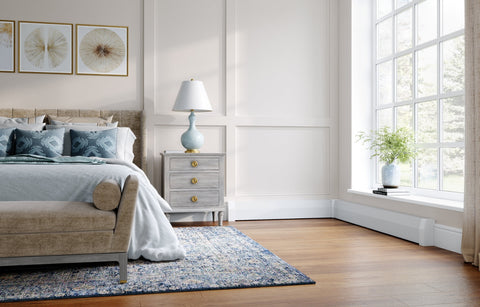Hydronic Baseboard Heating History: 1950 to Present

Hydronic baseboard heating has a history dating back several decades. It emerged as a popular heating method in the early 1950s. Since then, people widely use it in cold climate areas of North America. It is still a well-loved method of heating today.
Here's a little about its history and why it remains popular.
Beginnings
In the early 1950s, hydronic baseboard heating systems began to gain traction as an effective and efficient way to heat homes. This heating method utilizes hot water circulated through pipes and fins to provide warmth.
What Is Hydronic Baseboard Heating?
As stated, hydronic baseboard heating uses the circulation of hot water through pipes to create heat. A rather ingenious invention, it is more clean and sustainable than many other forms of heat.
Heated pipes radiate heat into the room and create a current of rising heated air that circulates around the room.

Hydronic System Design
The basic design of hydronic baseboard heating systems has remained relatively consistent over the years. The main parts of the system include a boiler or water heater for heating the water.
There is also a pump to circulate the hot water. Pipes are used to transport the water throughout the system. Additionally, there are baseboard units with fins that distribute the heat.
Durability
Manufacturers originally made baseboard heater covers of metal, and many still use them. These last a long time but can be prone to developing rust over time. The pipes, fins, and other functional elements can last for many decades.
Hydronic baseboard heating covers are prone to developing rust, which is why they end up looking less than desirable. Baseboarders are made of galvanized steel and powder coated, both of which help increase the cover's rust resistance.
The galvanized steel and powder coating of Baseboarders help increase the cover's rust resistance.
Shop Baseboarders®

Popularity Through Time
Hydronic baseboard heating quickly gained popularity because of its effectiveness in cold climates in the 1950s. It provided consistent heat distribution and many people considered it more comfortable than forced-air heating systems.
Today, people still widely use it, especially in the North East of the United States. Heating technology has not changed much since the 1950s, so hydronic baseboard heat is still a popular choice today.
Many people prefer different types of heating over baseboard heat because it is very noticeable and hasn't always been aesthetically pleasing. More on that in a minute.
Advantages
Hydronic baseboard heating has several advantages. The heater works quietly and doesn't spread dust or allergens. It also lets you control the temperature in different parts of the house.
Technological Advancements
Over time, engineers have made advancements to enhance the efficiency and convenience of hydronic baseboard heating systems. This involves making boilers and pumps more efficient and improving insulation to prevent heat loss.

Aesthetics
As mentioned before, people don't consider hydronic baseboard heat nice to look at. Initially, the focus of hydronic baseboard heating was primarily on functionality rather than aesthetics.
Manufacturers often made the baseboard units from simple, utilitarian materials like metal. Recently, there has been an increase in the desire for baseboard designs that look nice with home interiors.
That's exactly what prompted the establishment of Baseboarders®. Baseboarders was created by someone who wanted to easily upgrade their baseboard heaters without purchasing a new unit. They wanted a simple solution for improving their existing heaters.
This person sought a way to enhance their baseboard heaters without the need for a complete replacement. They desired a convenient method for updating their heaters. And if it could look nice, that would be a happy bonus.
When he found that no such solution existed, he went to work creating it himself. Thus Baseboarders was born. Replacing the cover of the baseboard heater with different designs and colors to give it a fresh look is easy.
Today we offer four different styles of baseboard heater covers, each designed to retrofit even the oldest installations.
Basic
Simple, square design for modern and minimal design styles. Can be used for standard straight wall installations and 90 degree inside corner installations. Comes in 3'-6' panel lengths and can be custom cut.
Premium
Top to bottom perforations offer a different lighter look and slight angling offers a bit of detail in the design. Can be used for straight, 90 degree inside or outside corners and 135 degree inside and outside corners. Comes in 2'-7' panel lengths and can be custom cut.
Premium Tall
The same design and features as the Premium cover but in a taller profile. Can be used for straight, 90 degree inside or outside corners and 135 degree inside and outside corners. Comes in 2'-7' panel lengths and can be custom cut.
Elliptus
A curved front with a horizontal line interrupting the perforations down the middle, Elliptus offers a solid, yet soft presence. Can be used for straight or 90 degree inside corner installations. Comes in 2'-7' panel lengths and can be custom cut.
Though the history of baseboard heaters is short and mostly unchanged over the years, it continues to be a reliable and widely used heating method. Now with Baseboarders, you can update your baseboard heaters quickly and easily. Plus, you'll get a style update that is rarely an option with baseboard heating.
Reevaluate Your Baseboard Heating Covers
